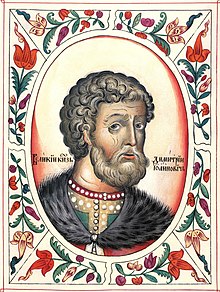This article needs additional citations for verification. (February 2023) |
| Dmitry Donskoy | |||||
|---|---|---|---|---|---|
 Miniature from the Tsarskiy titulyarnik ("Tsar's Book of Titles", 1672) | |||||
| Prince of Moscow | |||||
| Reign | 13 November 1359 – 19 May 1389 | ||||
| Predecessor | Ivan II | ||||
| Successor | Vasily I | ||||
| Grand Prince of Vladimir | |||||
| Reign | 1363 – 19 May 1389 | ||||
| Predecessor | Dmitry of Suzdal | ||||
| Successor | Vasily I | ||||
| Born | 12 October 1350 Moscow, Grand Duchy of Moscow | ||||
| Died | 19 May 1389 (aged 38) Moscow, Grand Duchy of Moscow | ||||
| Burial | |||||
| Consort | Eudoxia Dmitriyevna | ||||
| Issue more... | |||||
| |||||
| Dynasty | Rurik | ||||
| Father | Ivan II of Moscow | ||||
| Mother | Alexandra Vasilyevna Velyaminova | ||||
Dmitry Ivanovich Donskoy[a] (Russian: Дми́трий Ива́нович Донско́й; 12 October 1350 – 19 May 1389) was Prince of Moscow from 1359 and Grand Prince of Vladimir from 1363 until his death. He was the heir of Ivan II.
He was the first prince of Moscow to openly challenge Mongol authority in Russia. In traditional Russian historiography, he is regarded as a Russian national hero and a central figure of the Russian Middle Ages. His nickname, Donskoy ("of the Don"), alludes to his great victory against the Tatars in the Battle of Kulikovo (1380), which took place on the Don River.[1] He is venerated as a saint in the Orthodox Church with his feast day on 19 May.
Cite error: There are <ref group=lower-alpha> tags or {{efn}} templates on this page, but the references will not show without a {{reflist|group=lower-alpha}} template or {{notelist}} template (see the help page).
- ^ Asimov, Isaac. Asimov's Chronology of the World. New York: HarperCollins, 1989; p. 186.